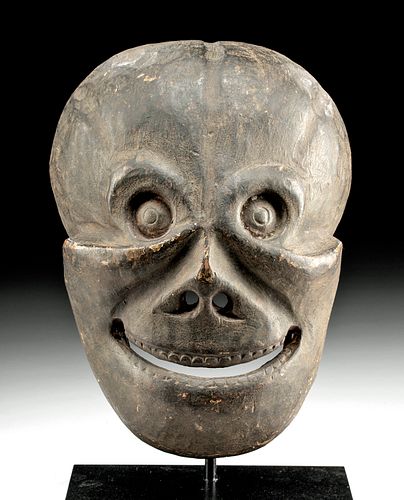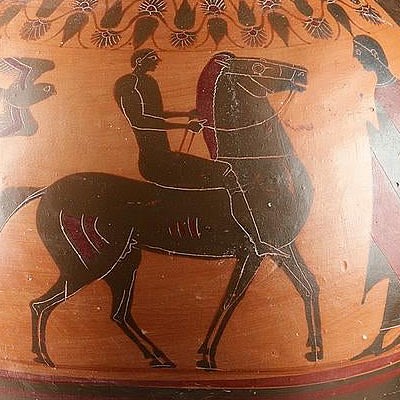19th C. Tibetan Wood Dance Mask Citipati Skeletal Deity
Lot 111a
About Seller
Artemis Gallery
686 S Taylor Ave, Ste 106
Louisville, CO 80027
United States
Selling antiquities, ancient and ethnographic art online since 1993, Artemis Gallery specializes in Classical Antiquities (Egyptian, Greek, Roman, Near Eastern), Asian, Pre-Columbian, African / Tribal / Oceanographic art. Our extensive inventory includes pottery, stone, metal, wood, glass and textil...Read more
Categories
Estimate:
$1,500 - $2,000
Absentee vs Live bid
Two ways to bid:
- Leave a max absentee bid and the platform will bid on your behalf up to your maximum bid during the live auction.
- Bid live during the auction and your bids will be submitted real-time to the auctioneer.
Bid Increments
| Price | Bid Increment |
|---|---|
| $0 | $25 |
| $300 | $50 |
| $1,000 | $100 |
| $2,000 | $250 |
| $5,000 | $500 |
| $10,000 | $1,000 |
| $20,000 | $2,500 |
| $50,000 | $5,000 |
| $100,000 | $10,000 |
| $200,000 | $20,000 |
About Auction
By Artemis Gallery
Jun 4, 2020
Set Reminder
2020-06-04 10:00:00
2020-06-04 10:00:00
America/New_York
Bidsquare
Bidsquare : Exceptional Antiquities, Asian, Ethnographic
https://www.bidsquare.com/auctions/artemis-gallery/exceptional-antiquities-asian-ethnographic-5185
An important one-day auction featuring museum-worthy examples of Egyptian, Greek, Roman, Etruscan, Near Eastern, Far East / Asian, Pre-Columbian, African / Tribal, Oceanic, Native American, Spanish Colonial, Russian, Fossils, Ancient Jewelry, Fine Art, so much more! Artemis Gallery info@artemisgallery.com
An important one-day auction featuring museum-worthy examples of Egyptian, Greek, Roman, Etruscan, Near Eastern, Far East / Asian, Pre-Columbian, African / Tribal, Oceanic, Native American, Spanish Colonial, Russian, Fossils, Ancient Jewelry, Fine Art, so much more! Artemis Gallery info@artemisgallery.com
- Lot Description
Central Asia, Tibet, ca. late 19th to early 20th century CE. A hand-carved wooden dance mask depicting the face of a Citipati, a skeletal protector deity in Tibetan Buddhism. The expressive mask bears gaunt cheek bones, a triangular nose with delineated nostrils, hemispherical eyes within recessed cavities, and a grinning mouth full of incised teeth. Traces of original white pigment are visible along the forehead and face, and red pigment can be seen within the mouth and eyes. Size: 6.2" W x 8.625" H (15.7 cm x 21.9 cm); 9.4" H (23.9 cm) on included custom stand.
Despite their bulging eyes, gnashing teeth and overall frightening appearance, the Citipati protect the Dharma (Buddhist teachings) from forces of dejection and ignorance. Typically depicted in pairs, the skeletons or Citipati (also known as Chitipati) represent a pair of lovers known as the Lord and Lady of the funeral pyre, whose sacred skeleton dance symbolizes the eternal dance of death as well as the arrival at absolute consciousness. In the traditional performance of the Tibetan Skeleton dance at cemeteries, the two Dharmapalas (Protectors of Truth) are played by Monks. They are deities whose primary role is to protect the cemetery grounds. Beyond this, their presence signifies the ephemeral nature of this earthly world and reminds the audience members of their own mortality. The cult of the "Second Buddha," Padmasambhava, planted the seed for this practice through their rich mythological literature.
Provenance: private Hawaii, USA collection
All items legal to buy/sell under U.S. Statute covering cultural patrimony Code 2600, CHAPTER 14, and are guaranteed to be as described or your money back.
A Certificate of Authenticity will accompany all winning bids.
We ship worldwide and handle all shipping in-house for your convenience.
#150514Minor nicks and abrasions to face, peripheries, and verso, with darkening to most original pigmentation, and light softening to some finer details, otherwise intact and very good. Light earthen deposits and faint traces of original pigment throughout. Old inventory label within verso.Condition
- Shipping Info
-
All shipping is handled in-house for your convenience. Your invoice from Artemis Gallery will include shipping calculation instructions. If in doubt, please inquire BEFORE bidding for estimated shipping costs for individual items.
-
- Buyer's Premium



 EUR
EUR CAD
CAD AUD
AUD GBP
GBP MXN
MXN HKD
HKD CNY
CNY MYR
MYR SEK
SEK SGD
SGD CHF
CHF THB
THB














